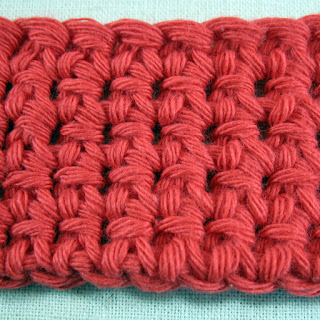Every now and again you're going to want to crochet some sort of cord. I know nothing about this subject so I thought I'd go on a voyage of discovery. This is what I've found out so far!
Up to now I've only ever used chain stitches or french knitting. I learnt french knitting as a child, when wooden cotton reels were still an everyday item. Now I use the fancy Prym french knitting mill. It definitely speeds up the process, but it does have it's limitations. The mill prefers a smooth 4 ply yarn. What it produces is basically a hollow stretchy tube.
None of the modern books on my shelf mention any kind of crochet cord. Instead I've had to go time travelling back to the 70's and 80's. Let's start with the most simple forms. I'm saving the best till last!
This sweetie is just a length of chain stitches with slip stitches made into the 'back bump'.
This one has slip stitches made into the top loop only. The finish is a little looser.
Here I've simply woven a number of threads through the chain stitches. You could also use ribbon or even a length of metal chain.
In this example I've actually made the chain stitches around the extra threads. You have to pass the threads between the hook and the working yarn. It took a few attempts to get it right. I definitely prefer this to the woven version.
Next, for your consideration I've got Irish Crochet cord. I'm not sure if you can really call it cord, but it would certainly be good for button loops. All it is is a number of threads of yarn which you Double crochet (Sc) around twice. Like this:
Have you heard of a Lucet? I think they're also called knitting forks. Having dipped into this on the Internet I've discovered that this is an art form all on it's own. If you'd like to find out more you could start by visiting the video made by It's all in a Nutshell here.
If you'd like to try it out before having to rush out and spend money have a go at this.
Tape together two crochet hooks of the same size. Luckily I just happen to have two! Start with a slip knot on the left hook and the yarn end hanging down in front.
Wrap the yarn around the hooks as I've done. Some instructions tell you to turn the 'Lucet' but it doesn't matter as long as you always work in the same order.
Use another crochet hook to pick up the left hand loop and lift it over the yarn wrap into the centre.
Now pick up the right hand loop, lift it over the yarn wrap and into the centre. Keep repeating these three actions, wrap the yarn, lift the left hand loop into the centre, lift the right hand loop into the centre.
Here are a couple I made earlier! (Don't forget to wash the sticky tape off your hooks before you use them next time!!)
Now we get to the really fun bit. This is where I'm feeling a bit smug. I found a few versions of the instructions for Basic Crochet Cord or Caterpillar Braid. It took me a few attempts to work out what to do but I love the result.
Start with a larger hook than usual and I'd also suggest a non splitty yarn, try to keep things loose, at least to start with.
Double Crochet (Sc) into the 2nd chain from the hook,
*Turn the work and Double Crochet (Sc) into the two bars on the left.
Repeat from * to the required length.
Once you've got the hang of the basic cord you can try these variations. This one I'm calling 'Topsy Turvy Braid'. It looks different on the front and back.
To make this one follow the instruction above turning it twice to the right to establish the braid. Then turn it alternately to the left and then the right. When you turn it to the left insert you hook underneath the working yarn, not over the top of it. You'll see what I mean when you get there!
This one is much easier! I'm calling it 'Half Treble (Hdc) Caterpillar braid'. Instead of making Double Crochets into those parallel stitches try Half Trebles.
Turn the work and look for the two vertical bars on the left,
Double crochet (Sc) into those two bars,*Turn the work and Double Crochet (Sc) into the two bars on the left.
Repeat from * to the required length.
Once you've got the hang of the basic cord you can try these variations. This one I'm calling 'Topsy Turvy Braid'. It looks different on the front and back.
To make this one follow the instruction above turning it twice to the right to establish the braid. Then turn it alternately to the left and then the right. When you turn it to the left insert you hook underneath the working yarn, not over the top of it. You'll see what I mean when you get there!
This one is much easier! I'm calling it 'Half Treble (Hdc) Caterpillar braid'. Instead of making Double Crochets into those parallel stitches try Half Trebles.
Or try using Trebles (Dc), like this example.
Why not go wild and make a three Treble (Dc) cluster into those parallel bars! Well really you could get carried away, but I thought that I'd better stop there.

































